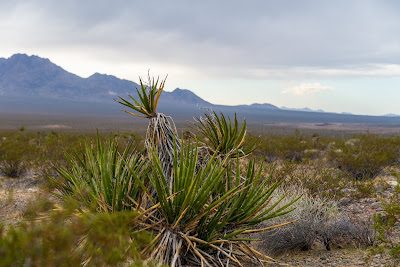Endangered Lane Mountain milk-vetch: The Push for Critical Habitat
The US Fish and Wildlife Service proposed designating critical habitat for the rare Mojave Desert plant--the Lane Mountain milk-vetch (Astragalus jaegerianus)--although off-highway vehicle enthusiasts have protested the move. If the proposal is enacted, it would be the final stretch in a long road by conservationists to win critical habitat protection for the Lane Mountain milk-vetch. The plant occurs in only 4 places, and it can survive for years underground thanks to a taproot that extracts whatever moisture is available deep underground. According to the USFWS, two of the 4 known populations are in decline, and all of the remaining plants are threatened by overlapping demands for the habitat.
Fort Irwin (National Training Center) expanded southward in 2001, so two primary pockets of the plants are on land managed by the US Army. Fort Irwin has implemented an integrated land management plan that sets aside areas of the base for conservation, keeping them safe from training maneuvers that would otherwise destroy the fragile desert ecosystem in which it is found.
Another two core populations are found outside of Fort Irwin lands, which have attracted illegal off-highway vehicle use. According to public comments submitted to the Fish and Wildlife Service, fencing off the nearly 14,000 acres proposed for the Lane Mountain milk-vetch critical habitat would deprive off-highway vehicle users of recreation area. The El Mirage, Stoddard Wells, and Johnson Valley Off-highway vehicle areas would not be affected by the critical habitat listing, however, and remain available for recreation.
The Lane Mountain milk-vetch was listed as an endangered species in 1998, although the US Fish and Widlife Service has waffled on granting the species critical habitat. Such a designation would limit incompatible uses of the land that could undermine the species' survival. The Service proposed critical habitat in 2004, but in a surprise move the Service decided to abandon the proposal in 2005, leaving the plant without habitat protections.
The Center for Biological Diversity protested the 2005 decision not to designate critical habitat, resulting in the Service's reversal last year and proposal to designate over 14,000 acres as critical habitat. The agency completed economic impact analysis and finished an extended public comment period in early December 2010. When the Service makes a final decision on the proposal later this year, you will get the update here.
Fort Irwin (National Training Center) expanded southward in 2001, so two primary pockets of the plants are on land managed by the US Army. Fort Irwin has implemented an integrated land management plan that sets aside areas of the base for conservation, keeping them safe from training maneuvers that would otherwise destroy the fragile desert ecosystem in which it is found.
Another two core populations are found outside of Fort Irwin lands, which have attracted illegal off-highway vehicle use. According to public comments submitted to the Fish and Wildlife Service, fencing off the nearly 14,000 acres proposed for the Lane Mountain milk-vetch critical habitat would deprive off-highway vehicle users of recreation area. The El Mirage, Stoddard Wells, and Johnson Valley Off-highway vehicle areas would not be affected by the critical habitat listing, however, and remain available for recreation.
 |
| Lane Mountain milk-vetch flowering in the Mojave Desert. (Credit: Cynthia Hopkins, USFWS) |
The Center for Biological Diversity protested the 2005 decision not to designate critical habitat, resulting in the Service's reversal last year and proposal to designate over 14,000 acres as critical habitat. The agency completed economic impact analysis and finished an extended public comment period in early December 2010. When the Service makes a final decision on the proposal later this year, you will get the update here.
 |
| The proposed critical habitat areas for the Lane Mountain milk-vetch in the western Mojave Desert. A final decision on the proposal is expected from the US Fish and Wildlife Service later this year. |


Comments
Post a Comment